The Japanese App Stores are a battlefield: the top grossing free-to-play apps rake in millions every day for their respective producers, jockeying for status and position on the charts, while thousands of others peter out after a few months or maintain a small but eagerly supportive audience. Others never even get off the ground – remember that Street Fighter card game? It went into beta around this time last year and nothing has come of it since. The freemium market might look like easy (or even greedy) money to a casual observer, but it’s actually a far harder nut to crack than most folks might think.
Monster Strike, a game which has been in a heated war with Puzzle and Dragons for top-grossing Japanese app for months, is noteworthy not only because it’s been such a huge hit in a very, very tough market, but because it’s something of a redemption story. Publisher Mixi operated a once-dominant social network in Japan that, in recent years, was rapidly losing ground to competitors like Facebook, Line, and Twitter – only to see business take a dramatic upwards turn as people picked up the game. The game’s designer, one Yoshiki Okamoto, is a man responsible for numerous classics at companies like Konami and Capcom, practically defining the late-80s-early-90s arcade legacy of the latter. Okamoto’s previous studio, Game Republic, suffered a terrible collapse after deals with western developers tanked, leaving them with massive debts that AAA development budgets require. Okamoto has now sworn off console development entirely, focusing strictly on mobile – thanks to Monster Strike’s roaring success. It might seem tragic at first, but knowing just how badly he got burned – and seeing just how fun Monster Strike is1 – Okamoto finding a new path and purpose in game development is actually a very happy story indeed.
I had an opportunity to talk with Okamoto and Koki Kimura, a producer at Mixi, about Monster Strike, along with Michael Oakland of Mixi’s localization team. We talked about the game and the ideas behind it, engaging in a lot of silliness in the process.
Let’s start with a question for Okamoto-san. What is it that first brought you to Mixi? At the time, they were mostly an SNS service, and not really involved in the mobile gaming space.
YO: I was quite a fan of the Mixi social networking service. The other reason was… well, I wanted to work with Kimura-san. We’d met previously, and we became fast friends because Kimura really liked my past work like Street Fighter, and I liked Mixi as a service. We actually did some small projects together previous to Monster Strike, and we had a lot of trust in each other as a result.
When it came right down to it, I could provide some things Mixi couldn’t do themselves, and Mixi had the capability to do things I couldn’t do alone. It really was a perfect combination; I figured we’d have a good chemistry in making a game together – and it turns out we did!
Your background is primarily in making arcade games. To me, Monster Strike has a very “arcadey” feel to it – it has easy-to-grasp controls, it puts the player into action and teaches them game mechanics right away to grab and keep their attention. Do you feel your arcade development experience had a strong influence on the game?
YO: (in English) YES! *laughs*
KK: Wait, is this a yes or no quiz now? *laughs*
YO: Well, I did use a lot of my experience in creating arcade games when designing Monster Strike. We explicitly designed it to be easy to pick up and play for short periods of time. Kind of like Street Fighter, the further you get along, the harder and more demanding it gets. You may hit that wall where you get defeated, and you’ll want to continue and improve. That’s another concept derived from my arcade experience. The rock-paper-scissors type elements with various enemy weaknesses derives from that as well.
I really do feel like this is a very “Okamoto” game, the kind of game you are best at making.
YO: I feel the same way, and I also feel that this might be the game I’ll be best known for, even outside of Japan.
KK: There are a few design elements I’d like to comment on. Since I was the producer, I asked Okamoto to do three things with Monster Strike:
– Make a game with really easy controls.
– Be able to play together with people in your vicinity.
– Create a feeling of excitement and tension.
Okamoto designed a system where your team’s hit points make large shifts up and down as you play. These large shifts increase the feeling of tension. But during quests, when you go up a map, your hit points refill by half, which brings a sense of relief and eagerness to keep going.
Is there anything specific from your previous work that you feel influenced the development or direction of Monster Strike?
YO: What I feel I have over other developers – and what I feel I bring to the Monster Strike development team – is my experience in making a lot of games. I’m able to see in my head the things that are going to be problems in the future, the things we can add. It’s given me a sort of intuition.
The concept of pulling and launching characters, sending them bouncing around a battlefield – where did it come from?
YO: It came from Osaka. *laughs*
MO: Uh, maybe we should let Kimura answer that. *laughs*
KK: *gets up* Well, it’s like a Monster Hunter-like action RPG. *makes like he’s swinging a weapon around* Whack! (In English) MOVE… AND… ATTACK! That’s the concept behind most action-RPGs. What we wanted to do is take the move-and-attack and make it into one easy command. The idea of pulling back and releasing something springy is intuitive to anyone. So, basically, we just combined those two ideas and made the “move and attack” into the act of pulling and launching your monsters.
The art style in the game is quite striking. It’s brightly colored with strongly defined lines, and reminds me of stuff like Bikkuriman and Shinra Bansho (Japanese collectible series that appeal strongly to kids). It’s quite a contrast to other mobile titles I see with more elaborate illustrations.
KK: In Japan, you have weekly manga magazines like Shonen Jump which are extremely popular. They tend to feature a similar art style, so that was definitely an influence. But even when you look at a game like Street Fighter – I mean, it’s a serious topic! People are beating each other up! But when you look at the character designs – silly stuff like Dhalsim and his yoga-stretchy limbs – there obvious comical elements to it. We thought that sort of comical look has a broader appeal across all audiences.
One thing I feel is a bit of an issue is how hard it can be to find co-op games at times. Japan has the benefit of having a lot of people concentrated in specific areas, whereas the population in the US is a lot more spread out.
MO: From a localization angle – when we were localizing the game, we wanted to showcase Mixi’s core value as a company – encouraging communication. During the loc process, we had to decide whether or not to include online play. We decided that not having online simply goes against the game’s core values. We’d rather have fewer players enjoying it the way it’s meant to be played than a lot of players with no online. We introduced Facebook and LINE invites, which allow you to play people from across the country. It is a bit inconvenient, but it’s a step to meet people in the middle.
KK: There have been some issues in Japan, too. If you’re in a place like rural Hokkaido, it’s considerably more difficult than in a city to find people to play with.
YO: It’s a little difficult to play with strangers in that sort of situation, but what you can do is get together with your family/friends and play. As the game becomes more popular, we think more people will begin to adopt that playstyle. You can’t play faraway players in board games and card games, for example, but that fact doesn’t stop people from creating and enjoying those sorts of games.
MO: We are going to focus on user education going forward. Like in Japan, we’ve got an online show where we get some celebrities to come on and get people pumped about the game.
You gotta get Gackt on there! *laughs*
KK: He actually came to Mixi to discuss something like that. Sadly, it didn’t work out. But yes, other games might have problems if they took the same route.
Have you looked into implementing some more popular mobile messaging services into the invite system?
MO: An early decision I made during the game’s localization was to include the invites, and as we look at the market and what apps are being used, it’s not too difficult to add more. If we see people using one app more than another, we’ll probably include it down the line.
One trend I’ve also noticed in Japanese mobile games is the tendency to give away a lot of premium currency upfront, as players are just starting out. Is there a psychology behind this? Does giving out more currency at the beginning of the game inspire players to spend more later on?
KK: Well, one reason is that Apple actually forces these games to give out free currency from time to time as a guideline. If you don’t do that, they won’t put you under the “free games” category, because eventually you will have to make a purchase.
Another thing is that we want to give people orbs as an incentive to keep playing. It’s true that Monster Strike does stack a lot of orbs at the beginning, but we don’t stop giving them out – you’ll keep getting orbs for all kinds of reasons. As you get further into the game, you’ll start getting a lot more of them as rewards. You’ll never really run out!
MO: I’m curious, are you doing single pulls or the ten-shots?
I do single pulls, because I’m impatient and want to spend the orbs as soon as I get them. *laughs*
MO: You actually get slightly better monsters with a ten-shot. But I was doing the single-shots as well on the US version, and I pulled Odin, Zeus, and Arthur (three very rare/strong monsters) not long after starting, all in a row-
YO: Cheater! You’re a cheater! *laughs*
MO: Yeah, that was some incredible luck.
YO: Still a cheater!
A lot of well-known figures in Japanese game development have shifted to mobile development lately. I’ve seen a lot of overseas fans lament this fact, however. I wonder if people really understand just how stressful console development can be. Do you feel mobile development is a better environment?
YO: I can’t say that I know what everyone else is up to, but I think I’m the only one who has gone completely over from console to mobile. A lot of developers are still doing both. I don’t think I can do that – I need to focus on just one or the other. I’m curious to see if any of these other folks dabbling in the mobile market will really succeed.
The reason why I do mobile dev now is because I think it’s the best interface – the best tool for the job, plus the largest audience. I simply want to give players the most fun experience possible.
I also feel like there’s a lot of pushback from core gamers against the free-to-play model.
KK: Well, let’s face it, there have been a lot of really bad free-to-play games that didn’t utilize the mechanic in a good way. We feel that the thing that will set us apart is the feeling of connection players get with other players. Things like network TV, Facebook, Twitter – those are all free services. Nobody is really opposed to them being free, because they’re communication tools. We feel like Monster Strike is also a means of communication, in its own way. Plus, if it’s a good game, being free-to-play is a good thing since it immediately lowers the barrier to entry. We’re proud that Monster Strike is free-to-play.
One last question, since we’re almost out of time – do you feel like Monster Strike is your “resurrection” after all the troubles that went down with Game Republic?
YO: Yes, I think it’s something of a grand return to gaming. If I hadn’t met Kimura and worked for Mixi, I’d likely be retired from the business by now, since I don’t know who else would have let me make a game I wanted to make after all that. Perhaps the meeting was destiny!
KK: We probably wouldn’t have succeeded without Okamoto, either.
YO: Yeah, Mixi would be gone by now, right? *laughs* So it was a win-win for everybody, really!
- my friend code is 621,637,408,850 add me I have a high level Margarite ↩
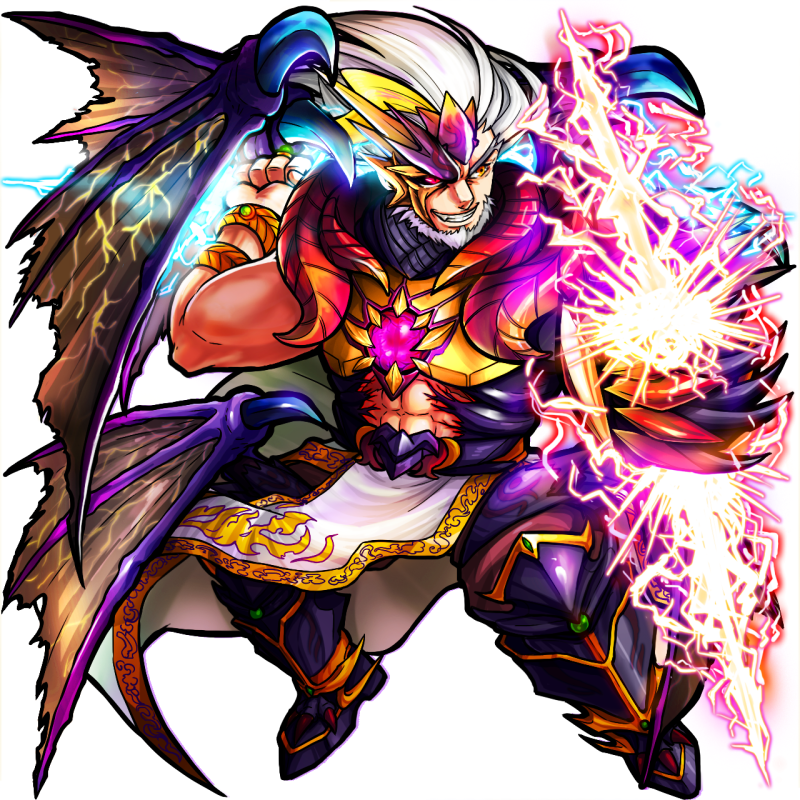
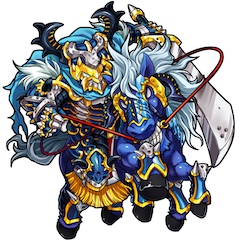
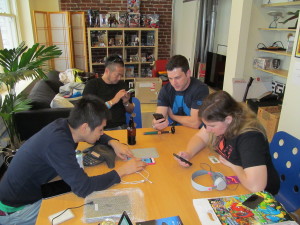
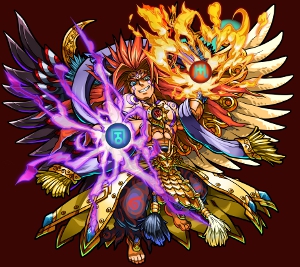
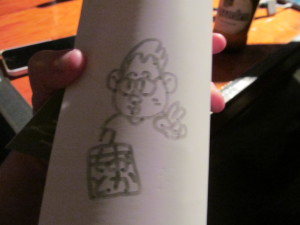
One Comment